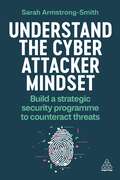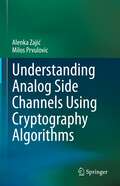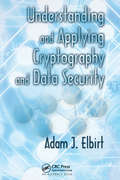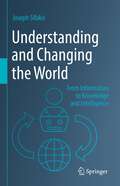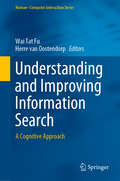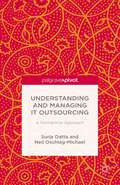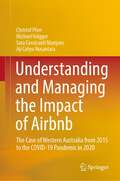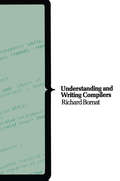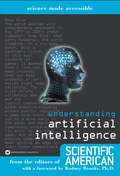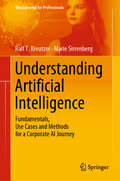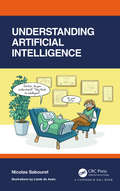- Table View
- List View
Understand Mathematics, Understand Computing: Discrete Mathematics That All Computing Students Should Know
by Arnold L. Rosenberg Denis TrystramIn this book the authors aim to endow the reader with an operational, conceptual, and methodological understanding of the discrete mathematics that can be used to study, understand, and perform computing. They want the reader to understand the elements of computing, rather than just know them. The basic topics are presented in a way that encourages readers to develop their personal way of thinking about mathematics. Many topics are developed at several levels, in a single voice, with sample applications from within the world of computing. Extensive historical and cultural asides emphasize the human side of mathematics and mathematicians.By means of lessons and exercises on “doing” mathematics, the book prepares interested readers to develop new concepts and invent new techniques and technologies that will enhance all aspects of computing. The book will be of value to students, scientists, and engineers engaged in the design and use of computing systems, and to scholars and practitioners beyond these technical fields who want to learn and apply novel computational ideas.
Understand the Cyber Attacker Mindset: Build a Strategic Security Programme to Counteract Threats
by Sarah Armstrong-SmithTo counteract a cyber attacker, organizations need to learn to think like one. Understand the Cyber Attacker Mindset explores the psychology of cyber warfare and how organizations can defend themselves against attacks. This book provides a comprehensive look at the inner workings of cyber attackers in the digital age and presents a set of strategies that organizations can deploy to counteract them. With technological advancements in cybersecurity, attackers are increasingly falling back to social engineering and preying on people's vulnerabilities. This book examines different types of cyber attackers, explores their motivations, and examines the methods used. It also reviews key industry developments such as cybercrime as a service, brokers and syndicates, nation-sponsored actors, insider sabotage and the challenges faced by law enforcement in tracking and apprehending attackers. Understand the Cyber Attacker Mindset offers expert, strategic guidance on how organizations can improve their cybersecurity operations in response, including enhancing security awareness training, educating employees to identify and resist manipulation, understanding the importance of cultural variances and how board-level decision-making can directly influence attacks. Written by a renowned cybersecurity leader, the book draws on interviews with ex-criminals and top experts in the field to share rich insights and a wide range of case studies profiling notable groups, such as Anonymous, Lapsus$, FIN7, Nigeria's Yahoo Boys, Sandworm, and the Lazarus Group. The human side of cybersecurity has never been so important.
Understanding 3D Animation Using Maya
by John Edgar ParkMany animators and designers would like to supplement their Maya learning with a less-technical, more helpful book. This self-study manual is both a general guide for understanding 3-D computer graphics and a specific guide for learning the fundamentals of Maya: workspace, modeling, animation, shading, lighting, and rendering. Understanding 3-D Animation Using Maya covers these fundamentals in each chapter so that readers gain increasingly detailed knowledge. After an initial 'concepts' section launches each chapter, hands-on tutorials are provided, as well as a chapter project that progressively adds newly learned material and culminates in the final animated short. This is the first book on Maya that teaches the subject using a sensible, proven methodology for both novices and intermediate users. Topics and features: - Proven method that emphasizes preliminaries to every chapter- Integrates the "why" concepts of 3-D simultaneously with the "how-to" techniques- Skills reinforced with tutorials and chapter projects- Real-world experience distilled into helpful hints and step-by-step guides for common tasks
Understanding Agent Systems (Springer Series on Agent Technology)
by Mark d’Inverno Michael LuckMark d'Inverno and Michael Luck present a formal approach to dealing with agents and agent systems in this second edition of Understanding Agent Systems. The Z specification language is used to establish an accessible and unified formal account of agent systems and inter-agent relationships. In particular, the framework provides precise and unambiguous meanings for common concepts and terms for agent systems, allows for the description of alternative agent models and architectures, and serves as a foundation for subsequent development of increasingly refined agent concepts. The practicability of this approach is verified by applying the formal framework to three detailed case studies. The book will appeal equally to researchers, students, and professionals in industry.
Understanding Agent Systems (Springer Series on Agent Technology)
by Mark d'Inverno Michael LuckMark d'Inverno and Michael Luck present a formal approach to dealing with agents and agent systems in this second edition of Understanding Agent Systems. The Z specification language is used to establish an accessible and unified formal account of agent systems and inter-agent relationships. In particular, the framework provides precise and unambiguous meanings for common concepts and terms for agent systems, allows for the description of alternative agent models and architectures, and serves as a foundation for subsequent development of increasingly refined agent concepts. The practicability of this approach is verified by applying the formal framework to three detailed case studies. The book will appeal equally to researchers, students, and professionals in industry.
Understanding Analog Side Channels Using Cryptography Algorithms
by Alenka Zajić Milos PrvulovicThis book offers the latest research results on analog side channels and their usage in cybersecurity. It demystifies analog side channels and demonstrates new use cases for them. The first part of this book discusses how analog side channels are generated, the physics behind it, the modeling and measurements of analog side channels, and their analogies to wireless communication systems. The second part of this book introduces new applications that benefit from leveraging side channels. In addition to breaking cryptography algorithms, it demonstrates how analog side channels can be used for malware detection, program profiling, hardware profiling, hardware/software attestation, hardware identification, and hardware Trojan detection.Side channel is one of the methods for obtaining information about program execution. Traditionally, they are used in computer science to extract information about a key in cryptographic algorithms. What makes them different from other ways of extracting information about program execution is that side channels rely on how a system implements program execution, rather than what the program’s algorithm specifies. Analog side channels are particularly powerful because they are not easy to suppress or detect that someone is collecting information from the system. Although they are very powerful tools, they are poorly understood.This book targets advanced level students in computer science and electrical engineering as a textbook. Researchers and professionals working with analog side channels, how to model them, measure them, improve signal to noise ratio, and invent new signal processing techniques can also use this book. Computer scientists and engineers who want to learn new applications of side channels to improve system security, new techniques for breaking cryptography keys, new techniques for attestation, and new techniques for hardware Trojan detection will also want to purchase this book.
Understanding and Applying Cryptography and Data Security
by Adam J. ElbirtA How-to Guide for Implementing Algorithms and ProtocolsAddressing real-world implementation issues, Understanding and Applying Cryptography and Data Security emphasizes cryptographic algorithm and protocol implementation in hardware, software, and embedded systems. Derived from the author's teaching notes and research publications, the text is des
Understanding and Applying Machine Vision, Revised and Expanded
by Nello ZeuchA discussion of applications of machine vision technology in the semiconductor, electronic, automotive, wood, food, pharmaceutical, printing, and container industries. It describes systems that enable projects to move forward swiftly and efficiently, and focuses on the nuances of the engineering and system integration of machine vision technology.
Understanding and Changing the World: From Information to Knowledge and Intelligence
by Joseph SifakisThis book discusses the importance of knowledge as an intangible asset, separate from physical entities, that can enable us to understand and/or change the world. It provides a thorough treatment of knowledge, one that is free of ideological and philosophical preconceptions, and which relies exclusively on concepts and principles from the theory of computing and logic. It starts with an introduction to knowledge as truthful and useful information, and its development and management by computers and humans. It analyses the relationship between computational processes and physical phenomena, as well as the processes of knowledge production and application by humans and computers. In turn, the book presents autonomous systems that are called upon to replace humans in complex operations as a step toward strong AI, and discusses the risks – real or hypothetical – of the careless use of these systems. It compares human and machine intelligence, attempting to answer the question of whether and to what extent computers, as they stand today, can approach human-level situation awareness and decision-making. Lastly, the book explains the functioning of individual consciousness as an autonomous system that manages short- and long-term objectives on the basis of value criteria and accumulated knowledge. It discusses how individual values are shaped in society and the role of institutions in fostering and maintaining a common set of values for strengthening social cohesion. The book differs from books on the philosophy of science in many respects, e.g. by considering knowledge in its multiple facets and degrees of validity and truthfulness. It follows the dualist tradition of logicians, emphasizing the importance of logic and language and considering an abstract concept of information very different from the one used in the physical sciences. From this perspective, it levels some hopefully well-founded criticism at approaches that consider information and knowledge as nothing more than the emergent properties of physical phenomena. The book strikes a balance between popular books that sidestep fundamental issues and focus on sensationalism, and scientific or philosophical books that are not accessible to non-experts. As such, it is intended for a broad audience interested in the role of knowledge as a driver for change and development, and as a common good whose production and application could shape the future of humanity.
Understanding and Evaluating Search Experience (Synthesis Lectures on Information Concepts, Retrieval, and Services)
by Stone MariaThis book is intended for anyone interested in learning more about how search works and how it is evaluated. We all use search—it's a familiar utility. Yet, few of us stop and think about how search works, what makes search results good, and who, if anyone, decides what good looks like. Search has a long and glorious history, yet it continues to evolve, and with it, the measurement and our understanding of the kinds of experiences search can deliver continues to evolve, as well. We will discuss the basics of how search engines work, how humans use search engines, and how measurement works. Equipped with these general topics, we will then dive into the established ways of measuring search user experience, and their pros and cons. We will talk about collecting labels from human judges, analyzing usage logs, surveying end users, and even touch upon automated evaluation methods. After introducing different ways of collecting metrics, we will cover experimentation as it applies to search evaluation. The book will cover evaluating different aspects of search—from search user interface (UI), to results presentation, to the quality of search algorithms. In covering these topics, we will touch upon many issues in evaluation that became sources of controversy—from user privacy, to ethical considerations, to transparency, to potential for bias. We will conclude by contrasting measuring with understanding, and pondering the future of search evaluation.
Understanding and Improving Information Search: A Cognitive Approach (Human–Computer Interaction Series)
by Wai Tat Fu Herre Van OostendorpThis edited book adopts a cognitive perspective to provide breadth and depth to state-of-the-art research related to understanding, analyzing, predicting and improving one of the most prominent and important classes of behavior of modern humans, information search. It is timely as the broader research area of cognitive computing and cognitive technology have recently attracted much attention, and there has been a surge in interest to develop systems and technology that are more compatible with human cognitive abilities. Divided into three interlocking sections, the first introduces the foundational concepts of information search from a cognitive computing perspective to highlight the research questions and approaches that are shared among the contributing authors. Relevant concepts from psychology, information and computing sciences are addressed. The second section discusses methods and tools that are used to understand and predict information search behavior and how the cognitive perspective can provide unique insights into the complexities of the behavior in various contexts. The final part highlights a number of areas of applications of which education and training, collaboration and conversational search interfaces are important ones. Understanding and Improving Information Search - A Cognitive Approach includes contributions from cognitive psychologists, information and computing scientists around the globe, including researchers from Europe (France, Netherlands, Germany), the US, and Asia (India, Japan), providing their unique but coherent perspectives to the core issues and questions most relevant to our current understanding of information search behavior and improving information search.
Understanding and Interpreting Machine Learning in Medical Image Computing Applications: First International Workshops, Mlcn 2018, Dlf 2018, And Imimic 2018, Held In Conjunction With Miccai 2018, Granada, Spain, September 16-20, 2018, Proceedings (Lecture Notes in Computer Science #11038)
by Danail Stoyanov Zeike Taylor Seyed Mostafa Kia Ipek Oguz Mauricio Reyes Anne Martel Lena Maier-Hein Andre F. Marquand Edouard Duchesnay Tommy Löfstedt Bennett Landman M. Jorge Cardoso Carlos A. Silva Sergio Pereira Raphael MeierThis book constitutes the refereed joint proceedings of the First International Workshop on Machine Learning in Clinical Neuroimaging, MLCN 2018, the First International Workshop on Deep Learning Fails, DLF 2018, and the First International Workshop on Interpretability of Machine Intelligence in Medical Image Computing, iMIMIC 2018, held in conjunction with the 21st International Conference on Medical Imaging and Computer-Assisted Intervention, MICCAI 2018, in Granada, Spain, in September 2018. The 4 full MLCN papers, the 6 full DLF papers, and the 6 full iMIMIC papers included in this volume were carefully reviewed and selected. The MLCN contributions develop state-of-the-art machine learning methods such as spatio-temporal Gaussian process analysis, stochastic variational inference, and deep learning for applications in Alzheimer's disease diagnosis and multi-site neuroimaging data analysis; the DLF papers evaluate the strengths and weaknesses of DL and identify the main challenges in the current state of the art and future directions; the iMIMIC papers cover a large range of topics in the field of interpretability of machine learning in the context of medical image analysis.
Understanding and Managing IT Outsourcing: A Partnership Approach
by S. Datta N. Oschlag-MichaelUnderstanding and Managing IT Outsourcing explains and illustrates how uncertainty and trust interact with each other, and how an understanding of this interaction is critical to success in IT outsourcing. A partnership approach that is built on trust can be the determinant of success but this book explains in which particular outsourcing context this approach is likely to pay dividends.
Understanding and Managing the Impact of Airbnb: The Case of Western Australia from 2015 to the COVID-19 Pandemic in 2020
by Michael Volgger Christof Pforr Sara Cavalcanti Marques Aji Cahya NusantaraThis book explores the rapid growth of the sharing economy, specifically of Airbnb, in recent years and how it has challenged traditional economies in many countries around the globe. With almost 5 million listings in more than 190 countries, many consider Airbnb as one of the most disruptive developments in tourism over the past decade. While this is a book about Western Australia as a case in point, the issues addressed in this book speak to the broader development of the sharing economy and its effects experienced nationally and indeed internationally. Thus, through the adoption of a case-specific analysis of the growth and impact of Airbnb, the book significantly contributes to closing existing knowledge gaps on the Airbnb phenomenon by exploring not only stakeholder perceptions of the sharing economy and Airbnb, the extent of Airbnb supply and demand, and how this differs from conventional accommodation demand, but also what policy responses have been employed in other tourism destinations worldwide. Western Australia in this regard serves as an exemplar case to shed light on the Airbnb phenomenon. This book presents a comprehensive global study that has investigated the Airbnb phenomenon from a supply, demand, stakeholder, and government response perspective and thus offers new empirical insights, which are of interest to government agencies and the tourism sector and are a valuable source of data to inform current policy debate.
Understanding and Servicing Alarm Systems
by H. William TrimmerUnderstanding and Servicing Alarm Systems, Third Edition has seen the alarm industry enter the computer age. With its coverage of microcomputerized controls, sophisticated detection devices, methods of alarm reporting, that second edition broke new ground. Now completely updated to reflect the security industry's most high-tech advances, the third edition of Understanding and Servicing Alarm Systems, continues on the road of educating the alarm dealer, installer, and technician. Prepares readers for the practicalities of dealing with customers Takes readers from the basics of electricity to the most modern equipment installation and repair Teaches the pitfalls one might encounter in the alarm servicing profession, along with the approaches for troubleshooting
Understanding and Using Linear Programming (Universitext)
by Jiri Matousek Bernd GärtnerThe book is an introductory textbook mainly for students of computer science and mathematics. Our guiding phrase is "what every theoretical computer scientist should know about linear programming". A major focus is on applications of linear programming, both in practice and in theory. The book is concise, but at the same time, the main results are covered with complete proofs and in sufficient detail, ready for presentation in class. The book does not require more prerequisites than basic linear algebra, which is summarized in an appendix. One of its main goals is to help the reader to see linear programming "behind the scenes".
Understanding and Using Rough Set Based Feature Selection: Concepts, Techniques and Applications
by Muhammad Summair Raza Usman QamarThe book will provide: 1) In depth explanation of rough set theory along with examples of the concepts. 2) Detailed discussion on idea of feature selection. 3) Details of various representative and state of the art feature selection techniques along with algorithmic explanations. 4) Critical review of state of the art rough set based feature selection methods covering strength and weaknesses of each. 5) In depth investigation of various application areas using rough set based feature selection. 6) Complete Library of Rough Set APIs along with complexity analysis and detailed manual of using APIs 7) Program files of various representative Feature Selection algorithms along with explanation of each.The book will be a complete and self-sufficient source both for primary and secondary audience. Starting from basic concepts to state-of-the art implementation, it will be a constant source of help both for practitioners and researchers. Book will provide in-depth explanation of concepts supplemented with working examples to help in practical implementation. As far as practical implementation is concerned, the researcher/practitioner can fully concentrate on his/her own work without any concern towards implementation of basic RST functionality. Providing complexity analysis along with full working programs will further simplify analysis and comparison of algorithms.
Understanding and Using Rough Set Based Feature Selection: Concepts, Techniques and Applications
by Muhammad Summair Raza Usman QamarThis book provides a comprehensive introduction to rough set-based feature selection. Rough set theory, first proposed by Zdzislaw Pawlak in 1982, continues to evolve. Concerned with the classification and analysis of imprecise or uncertain information and knowledge, it has become a prominent tool for data analysis, and enables the reader to systematically study all topics in rough set theory (RST) including preliminaries, advanced concepts, and feature selection using RST. The book is supplemented with an RST-based API library that can be used to implement several RST concepts and RST-based feature selection algorithms.The book provides an essential reference guide for students, researchers, and developers working in the areas of feature selection, knowledge discovery, and reasoning with uncertainty, especially those who are working in RST and granular computing. The primary audience of this book is the research community using rough set theory (RST) to perform feature selection (FS) on large-scale datasets in various domains. However, any community interested in feature selection such as medical, banking, and finance can also benefit from the book. This second edition also covers the dominance-based rough set approach and fuzzy rough sets. The dominance-based rough set approach (DRSA) is an extension of the conventional rough set approach and supports the preference order using the dominance principle. In turn, fuzzy rough sets are fuzzy generalizations of rough sets. An API library for the DRSA is also provided with the second edition of the book.
Understanding and Using the Controller Area Network Communication Protocol: Theory and Practice
by Marco Di Natale Haibo Zeng Paolo Giusto Arkadeb GhosalThis book to offers a hands-on guide to designing, analyzing and debugging a communication infrastructure based on the Controller Area Network (CAN) bus. Although the CAN bus standard is well established and currently used in most automotive systems, as well as avionics, medical systems and other devices, its features are not fully understood by most developers, who tend to misuse the network. This results in lost opportunities for better efficiency and performance. These authors offer a comprehensive range of architectural solutions and domains of analysis. It also provides formal models and analytical results, with thorough discussion of their applicability, so that it serves as an invaluable reference for researchers and students, as well as practicing engineers.
Understanding Artificial Intelligence
by Editors of Scientific AmericanDrawn from the pages of Scientific American and collected here for the first time, this work contains updated and condensed information, made accessible to a general popular science audience, on the subject of artificial intelligence.
Understanding Artificial Intelligence: Fundamentals, Use Cases and Methods for a Corporate AI Journey (Management for Professionals)
by Ralf T. Kreutzer Marie SirrenbergArtificial Intelligence (AI) will change the lives of people and businesses more fundamentally than many people can even imagine today. This book illustrates the importance of AI in an era of digitalization. It introduces the foundations of AI and explains its benefits and challenges for companies and entire industries. In this regard, AI is approached not just as yet another technology, but as a fundamental innovation, which will spread into all areas of the economy and life, and will disrupt business processes and business models in the years to come. In turn, the book assesses the potential that AI holds, and clarifies the framework that is necessary for pursuing a responsible approach to AI. In a series of best-practice cases, the book subsequently highlights a broad range of sectors and industries, from production to services; from customer service to marketing and sales; and in industries like retail, health care, energy, transportation and many more. In closing, a dedicated chapter outlines a roadmap for a specific corporate AI journey.No one can ignore intensive work with AI today - neither as a private person, let alone as a top performer in companies. This book offers a thorough, carefully crafted, and easy to understand entry into the field of AI. The central terms used in the AI context are given a very good explanation. In addition, a number of cases show what AI can do today and where the journey is heading. An important book that you should not miss!Professor Dr. Harley KrohmerUniversity of Bern"Inspiring, thought provoking and comprehensive, this book is wittingly designed to be a catalyst for your individual and corporate AI journey.”Avo Schönbohm, Professor at the Berlin School of Economics and Law, Enterprise Game Designer at LUDEO and Business Punk
Understanding Artificial Intelligence: Fundamentals and Applications
by Albert Chun-Chen Liu Oscar Ming Law Iain LawUnderstanding Artificial Intelligence Provides students across majors with a clear and accessible overview of new artificial intelligence technologies and applications Artificial intelligence (AI) is broadly defined as computers programmed to simulate the cognitive functions of the human mind. In combination with the Neural Network (NN), Big Data (BD), and the Internet of Things (IoT), artificial intelligence has transformed everyday life: self-driving cars, delivery drones, digital assistants, facial recognition devices, autonomous vacuum cleaners, and mobile navigation apps all rely on AI to perform tasks. With the rise of artificial intelligence, the job market of the near future will be radically different???many jobs will disappear, yet new jobs and opportunities will emerge. Understanding Artificial Intelligence: Fundamentals and Applications covers the fundamental concepts and key technologies of AI while exploring its impact on the future of work. Requiring no previous background in artificial intelligence, this easy-to-understand textbook addresses AI challenges in healthcare, finance, retail, manufacturing, agriculture, government, and smart city development. Each chapter includes simple computer laboratories to teach students how to develop artificial intelligence applications and integrate software and hardware for robotic development. In addition, this text: Focuses on artificial intelligence applications in different industries and sectors Traces the history of neural networks and explains popular neural network architectures Covers AI technologies, such as Machine Vision (MV), Natural Language Processing (NLP), and Unmanned Aerial Vehicles (UAV) Describes various artificial intelligence computational platforms, including Google Tensor Processing Unit (TPU) and Kneron Neural Processing Unit (NPU) Highlights the development of new artificial intelligence hardware and architectures Understanding Artificial Intelligence: Fundamentals and Applications is an excellent textbook for undergraduates in business, humanities, the arts, science, healthcare, engineering, and many other disciplines. It is also an invaluable guide for working professionals wanting to learn about the ways AI is changing their particular field.
Understanding Artificial Intelligence: Fundamentals and Applications
by Albert Chun-Chen Liu Oscar Ming Law Iain LawUnderstanding Artificial Intelligence Provides students across majors with a clear and accessible overview of new artificial intelligence technologies and applications Artificial intelligence (AI) is broadly defined as computers programmed to simulate the cognitive functions of the human mind. In combination with the Neural Network (NN), Big Data (BD), and the Internet of Things (IoT), artificial intelligence has transformed everyday life: self-driving cars, delivery drones, digital assistants, facial recognition devices, autonomous vacuum cleaners, and mobile navigation apps all rely on AI to perform tasks. With the rise of artificial intelligence, the job market of the near future will be radically different???many jobs will disappear, yet new jobs and opportunities will emerge. Understanding Artificial Intelligence: Fundamentals and Applications covers the fundamental concepts and key technologies of AI while exploring its impact on the future of work. Requiring no previous background in artificial intelligence, this easy-to-understand textbook addresses AI challenges in healthcare, finance, retail, manufacturing, agriculture, government, and smart city development. Each chapter includes simple computer laboratories to teach students how to develop artificial intelligence applications and integrate software and hardware for robotic development. In addition, this text: Focuses on artificial intelligence applications in different industries and sectors Traces the history of neural networks and explains popular neural network architectures Covers AI technologies, such as Machine Vision (MV), Natural Language Processing (NLP), and Unmanned Aerial Vehicles (UAV) Describes various artificial intelligence computational platforms, including Google Tensor Processing Unit (TPU) and Kneron Neural Processing Unit (NPU) Highlights the development of new artificial intelligence hardware and architectures Understanding Artificial Intelligence: Fundamentals and Applications is an excellent textbook for undergraduates in business, humanities, the arts, science, healthcare, engineering, and many other disciplines. It is also an invaluable guide for working professionals wanting to learn about the ways AI is changing their particular field.
Understanding Artificial Intelligence
by Nicolas SabouretArtificial Intelligence (AI) fascinates, challenges and disturbs us. There are many voices in society that predict drastic changes that may come as a consequence of AI – a possible apocalypse or Eden on earth. However, only a few people truly understand what AI is, what it can do and what its limitations are. Understanding Artificial Intelligence explains, through a straightforward narrative and amusing illustrations, how AI works. It is written for a non-specialist reader, adult or adolescent, who is interested in AI but is missing the key to understanding how it works. The author demystifies the creation of the so-called "intelligent" machine and explains the different methods that are used in AI. It presents new possibilities offered by algorithms and the difficulties that researchers, engineers and users face when building and using such algorithms. Each chapter allows the reader to discover a new aspect of AI and to become fully aware of the possibilities offered by this rich field.

